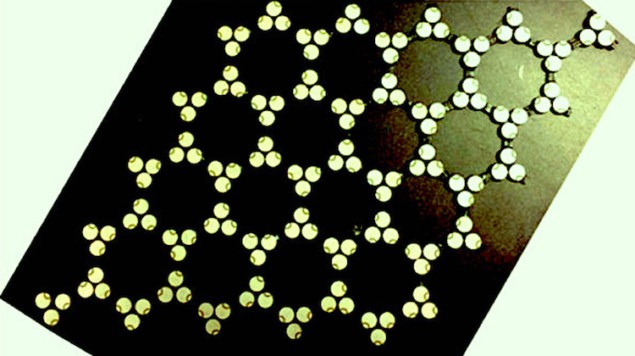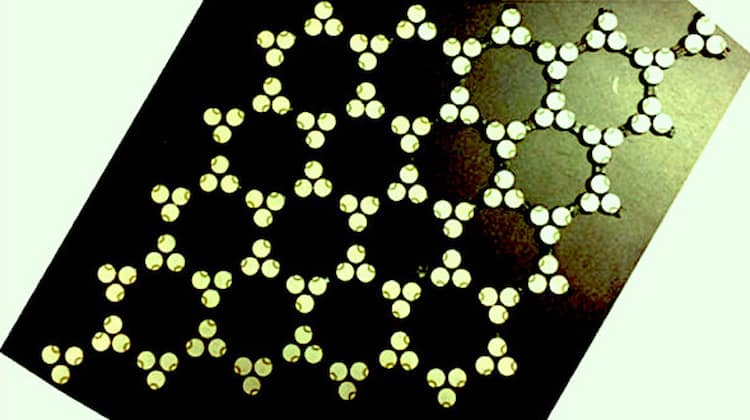
Researchers have succeeded in controllably propagating sound waves along the boundaries of topological metamaterials using a modulation technique that breaks time-reversal symmetry. This feat, which was accomplished by a team of researchers based at Georgia Tech and the City University of New York (CUNY) and led by Andrea Alù, could lead to applications in areas as diverse as ultrasound imaging, sonar and low-power electronic devices that can operate in harsh or hazardous environments.
Research on topological materials took off in the early years of this century with the discovery of topological insulators – materials that conduct electricity extremely well on their surface, while acting as insulators in their bulk. Electrons on the surface of such insulators can travel in only one direction and cannot backscatter from impurities or defects in the material without reversing the direction of their spins. This remarkable behaviour allows topological materials to carry electrical current almost without dissipation, which means they could someday be used to make electronic devices that are far more energy-efficient than any that exist today.
Topological control of phonons
More recently, researchers have also developed topological insulators that can control the propagation of phonons (vibrations of the crystal lattice in solids) along static and dynamical edge states. In particular, Alù and CUNY’s Alexander Khanikaev exploited geometrical asymmetries to produce topological behaviour in 3D-printed acoustic metamaterials, with the result that sound waves were confined to travel only along the edges of the metamaterial – including around sharp corners.
These earlier materials, however, had an important shortcoming: the sound waves were not fully constrained, and could travel forward and backward along the insulator’s edges. This freedom of travel occurred because certain types of disorder or imperfections in the material could reflect the sound as it propagated along the object’s boundaries.
Time-reversal symmetry breaking
The new work, which is detailed in Science Advances, overcomes this drawback by showing that time-reversal symmetry breaking, rather than geometrical asymmetries, can also induce topological order in a material.
The concept of time-reversal (TR) symmetry in electronics dates back to 1987, when physicists in the Soviet Union predicted the existence of electronic states that behave like a magnetic field, pointing in a different direction when the “arrow of time” is reversed in the equations that describe them. Such states are said to have TR symmetry.
In a topological insulator, TR symmetry can be broken by doping the material with magnetic atoms or interfacing its surface with a magnetic layer that causes an electronic energy gap to open at the point at which its electron valence and conduction bands just touch each other (the Dirac point). In their experiments, Alù and colleagues created such conditions in a topological insulating device made of hexagonal arrays of circular piezoelectric resonators bonded to a thin disk of polylactic acid. They connected their system to external integrated electronic circuits, which provided electrical signals that they could then use to modulate the resonators in space and time. These signals impart a “synthetic angular momentum bias” that in turn induces a strong topological protection on the device’s edges.

Time reversal symmetry breaks in ferromagnetic Weyl semimetals
Using this approach, the researchers found that sound propagation became truly unidirectional and robust against disorder and imperfections. “The result is a breakthrough for topological physics, as we have been able to show topological order emerging from time variations, which is different and more advantageous than the large body of work on topological acoustics based on geometrical asymmetries,” Alù stated in a press release issued by CUNY. “Previous approaches required the presence of a backward channel through which sound could be reflected, which inherently limited their topological protection. With time modulations we can suppress backward propagation and provide strong topological protection.”
And that is not all: the design also enables the researchers to guide sound waves along a variety of different reconfigurable paths, with minimal loss. According to Alù, the system may find applications in acoustic emitters and mechanical logic circuits, as well as ultrasound imaging, sonar and electronic systems that exploit surface acoustic wave technology.
